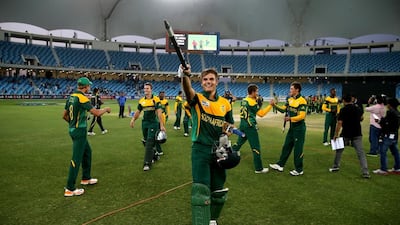DUBAI // Just the sight of a major international trophy is usually enough to have South African cricketers choking on their boerewors. Not this time.
Even when losing seemed to be nigh on impossible, players wearing the Proteas crest have almost always contrived to find a way in knock-out cricket on the biggest stages.
Not this time. These boys are so young, they probably do not even know who Lance Klusener is. Some of them were only two years old, after all, when the most famous World Cup choke of all happened, at Edgbaston in 1999.
Each of them probably knows how to read a Duckworth-Lewis chart, too – not that it was required with the fine weather here unlike Shaun Pollock, Mark Boucher and Co in 2003.
There were no dropped bats, misheard calls or general pandemonium this time around.
Instead, Aiden Markram, their composed captain, carried his Gunn and Moore for 66 and, in the process, his side to the world title. It must have tasted sweet.
“The boys are ecstatic and I don’t think it has settled in yet,” Markram said.
“Knowing we are world champions is a special feeling and a blessed honour as well.
“I felt it was inevitable that it was eventually going to happen. We are just the lucky ones to be sitting here. I’m glad we could have done it for our country.”
Maybe this South Africa side benefited from the fact they were essentially unknown coming into this competition. The burden of expectation was relatively light.
Not that any side of teenagers could ever exactly be too well known.
But it was taken as a given at the start of this series that India and Australia, for example, would be well placed to reprise their final meeting of two years previously, and that Pakistan would be there or thereabouts when the silverware was handed out.
Even England, traditionally underachievers at this level of the sport, had boosted their credentials ahead of this event via a lengthy warm-up series on these shores in December.
But South Africa?
Few of them have ever been spotted at a first-class fixture, they have had little experience of international touring life and they were only really introduced to each other last July.
Experience can be overrated, though. Especially when you have talent of the ilk of Kagiso Rabada, Clyde Fortuin, Corbin Bosch and their leader Markram.
Rabada was mean as he took a wicket and leaked just the 26 runs from his 10 overs.
There is no doubt his fellow bowlers benefited from the fact the batsmen let their defences slip once they had escaped his searing pace.
Fortuin, the quicksilver gloveman, missed out with the bat but took six catches at the wicket.
Bosch seldom erred from off stump with the ball and was rewarded with four wickets and the man-of-the-match award.
Markram’s half-century, meanwhile, was just the latest in a series of captain’s knocks that earned him the player-of-the-tournament gong.
He betrayed no signs of nerves on the outside, but he said the appearance was misleading.
“The crowd were very intimidating, it was so loud and it echoed throughout the stadium,” the captain said.
“It made it that much more difficult, but we had to knuckle down and get the job done.”
In truth it was an anti-climactic final.
After opting to bat, Pakistan crumbled to 131 all out and, despite two early wickets, the chase was easy for the South Africans.
“We started the preparation for this World Cup nine months back and we had had three tours,” said Sami Aslam, the Pakistan captain.
“We had played very good cricket coming to the final. But South Africa bowled well, two or three batsmen played poor shots and on the day, they played better than us.”
pradley@thenational.ae
Follow us on Twitter at SprtNationalUAE


